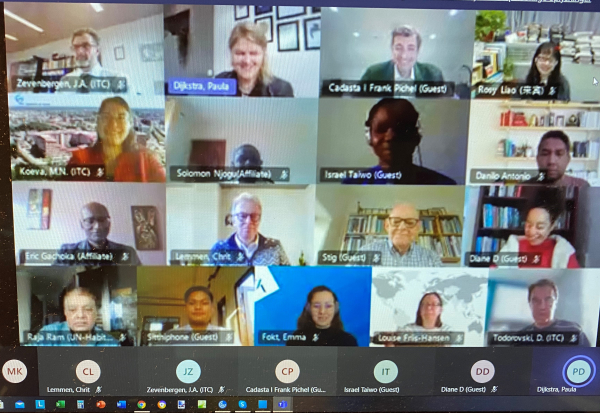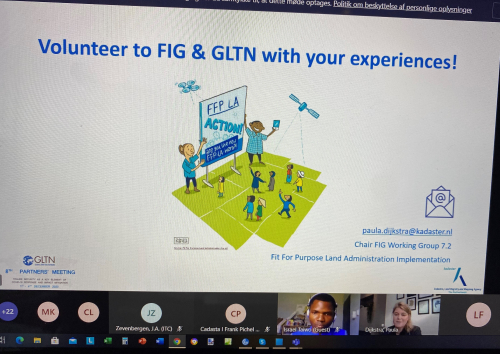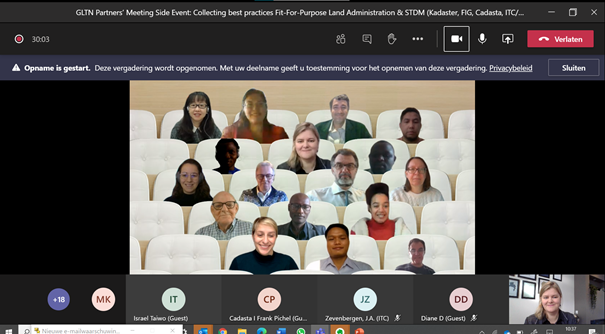

News in 2020
|
| What are the experiences with the current implementations of Fit For Purpose Land Administration (FFP LA), what are lessons learned and are there similarities when implementing the concept in different places and contexts? |
|
That were the key questions during the side event of the 8th GLTN
Partner Meeting at the beginning of December. FIG and other GLTN
partners such as Kadaster, Cadasta Foundation, ITC faculty of University
Twente and the VCSP reflected on the developments and provided a
foundation for an interactive debate.
Since the launch of the concepts STDM (2010) and Fit For Purpose Land
Administration (2014) partners of GLTN have contributed to the
implementation of these concepts in different places, different contexts
and at different levels all over the world. During this side event we
will focus on how, as partners, we can collect experiences and lessons
learned from projects in the world where principles of the FFP approach
and STDM were applied.

At the start of the session Diane Dumashie (FIG) set the scene by indicating that the FFP LA and STDM approaches are bridging mechanisms for cooperation and that for further upscaling a publication on implementations of FFP LA is key. As well as the importance of learning from the different blockers in the processes and within our profession.
This was followed by an introduction of Paula Dijkstra on the efforts of FIG towards the FFP LA implementation as well as an introduction on the concepts of the continuum of land rights, FFP LA and STDM by Chrit Lemmen. br /> Solomon Njogu presented on behalf of GLTN on how the concepts were applied in different settings, with the valuable lessons learned. STDM has become an important tool for tenure security improvement and a valuable contribution to implementation of FFP LA.
The guide ‘Fit-For-Purpose Land Administration for All’ was
introduced by Eva-Maria Unger. This report shows the importance of
fostering strategic partnerships amongst all land sector stakeholders -
government, private sector, NGOs, and academia - when undertaking FFP
LA. The inspiring and spot-on graphics are a good addition to the
valuable content.
The Cadasta Foundation is involved in several implementation projects
and Frank Pichel inspired the participants on different methods that
were applied, as well how you can bridge the gap between top down and
bottom-up approaches. Also he shared the experiences on how the projects
were continued despite the unexpected ‘blocker’ of COVID-19.
The project Its4Land was concluded this year, with the delivery of six new tools to make land rights mapping faster, cheaper, easier, and more responsible. Mila Koeva from ITC, Faculty of University of Twente presented the tools and linked them to the FFP LA principles.
Also the innovative Voluntary Community Surveying Program of FIG and GLTN was presented by Israel Taiwo. He focused on how the next generation of surveyors can be involved in the FFPLA processes through VCSP.

The valuable insights from the session will be used in a publication on Fit For Purpose Land Administration implementation. This publication will be prepared by FIG and GLTN and supported by Kadaster and ITC. The publication will reflect on how the concept was further developed since the publication. Stakeholders involved with the implementation of FFP LA will share their best practices and observations from their different perspectives and backgrounds. Based on the collection of best practices the publication will focus on recommendations to further accelerate the efforts to document, record and recognize people to land relationships in all forms.

Some of the participants at the side event
Paula Dijkstra
December 2020